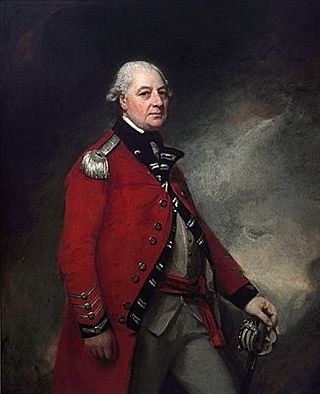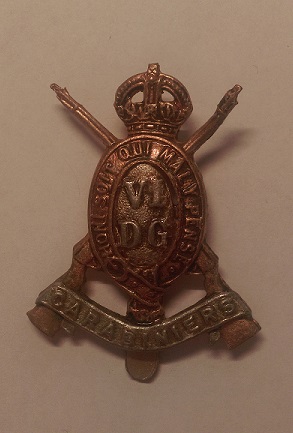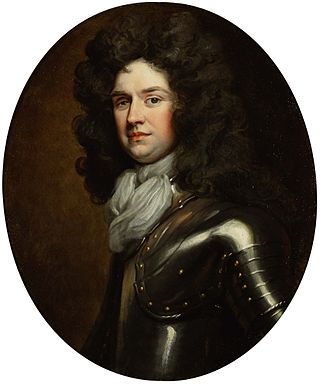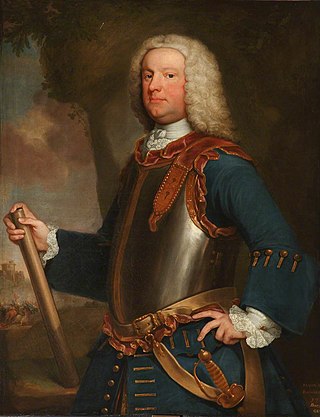Lieutenant General William Evans | |
|---|---|
| Allegiance | |
| Service/ | British Army |
| Rank | Lieutenant-general |
| Battles/wars | War of the Spanish Succession |
Lieutenant-General William Evans was a British Army General who became governor of the Royal Hospital Chelsea.
Lieutenant General William Evans | |
|---|---|
| Allegiance | |
| Service/ | British Army |
| Rank | Lieutenant-general |
| Battles/wars | War of the Spanish Succession |
Lieutenant-General William Evans was a British Army General who became governor of the Royal Hospital Chelsea.
In 1713, during the War of the Spanish Succession, Evans was invited by the Duke of Ormonde to serve in Flanders and acquired a Regiment of Dragoons when Viscount Cobham was stripped of his regiment. [1] The regiment became known as Evans's Dragoons. [2]
He was promoted to lieutenant general in 1727 [3] and in 1728 King George II and Queen Caroline inspected his regiment. [4]
He was also governor of the Royal Hospital Chelsea from 1722 until 1740. [5]

Field Marshal George Wade was a British Army officer who served in the Nine Years' War, War of the Spanish Succession, Jacobite rising of 1715 and War of the Quadruple Alliance before leading the construction of barracks, bridges and proper roads in Scotland. He went on to be a military commander during the War of the Austrian Succession and Commander-in-Chief of the Forces during the Jacobite rising of 1745.

Field Marshal John Ligonier, 1st Earl Ligonier,, was a French Huguenot exile, born Jean Louis de Ligonier in Castres, Southern France. He had a long and distinguished career in the British army and was appointed Commander-in-chief in 1757.

Richard Temple, 1st Viscount Cobham was a British soldier and Whig politician. After serving as a junior officer under William III during the Williamite War in Ireland and during the Nine Years' War, he fought under John Churchill, 1st Duke of Marlborough, during the War of the Spanish Succession. During the War of the Quadruple Alliance Temple led a force of 4,000 troops on a raid on the Spanish coastline which captured Vigo and occupied it for ten days before withdrawing. In Parliament he generally supported the Whigs but fell out with Sir Robert Walpole in 1733. He was known for his ownership of and modifications to the estate at Stowe and for serving as a political mentor to the young William Pitt.

Field Marshal Sir Robert Rich, 4th Baronet was a British cavalry officer. As a junior officer he fought at the Battle of Schellenberg and at the Battle of Blenheim during the War of the Spanish Succession. He was then asked to raise a regiment to combat the threat from the Jacobite rising of 1715. He also served with the Pragmatic Army under the Earl of Stair at the Battle of Dettingen during the War of the Austrian Succession. As a Member of Parliament he represented three different constituencies but never attained political office.

Field Marshal Richard Molesworth, 3rd Viscount Molesworth, PC (Ire) FRS, styled The Honourable Richard Molesworth from 1716 to 1726, was an Anglo-Irish military officer, politician and nobleman. He served with his regiment at the Battle of Blenheim before being appointed aide-de-camp to the Duke of Marlborough during the War of the Spanish Succession. During the Battle of Ramillies Molesworth offered Marlborough his own horse after Marlborough fell from the saddle. Molesworth then recovered his commander's charger and slipped away: by these actions he saved Marlborough's life. Molesworth went on Lieutenant of the Ordnance in Ireland and was wounded at the Battle of Preston during the Jacobite rising of 1715 before becoming Master-General of the Ordnance in Ireland and then Commander-in-Chief of the Royal Irish Army.

Field Marshal James O'Hara, 2nd Baron Tyrawley and 1st Baron Kilmaine, PC, was an Irish officer in the British Army. After serving as a junior officer in Spain and the Low Countries during the War of the Spanish Succession, he went on to become British ambassador to Lisbon establishing a close relationship with King John V there. He undertook a tour as British ambassador to Saint Petersburg before becoming Governor of Gibraltar where he set about improving the fortifications. He was briefly commander of British troops in Portugal during the Seven Years' War but was replaced within a few months. During his military career, he was colonel of eight different regiments.

Field Marshal Sir George Howard KB, PC was a British military officer and politician. After commanding the 3rd Regiment of Foot at the Battle of Fontenoy in May 1745 during the War of the Austrian Succession and after commanding that regiment again at the Battle of Falkirk Muir and the Battle of Culloden during the Jacobite Rebellion, he returned to the continent and fought at the Battle of Lauffeld. He went on to command a brigade at the Battle of Warburg during the Seven Years' War. He subsequently became the Governor of Minorca.

Field Marshal George Townshend, 1st Marquess Townshend, PC, known as The Viscount Townshend from 1764 to 1787, was a British soldier and politician. After serving at the Battle of Dettingen during the War of the Austrian Succession and the Battle of Culloden during the Jacobite Rising, Townshend took command of the British forces for the closing stages of the Battle of the Plains of Abraham during the Seven Years' War. He went on to be Lord Lieutenant of Ireland or Viceroy where he introduced measures aimed at increasing the size of Irish regiments, reducing corruption in Ireland and improving the Irish economy. In cooperation with Prime Minister North in London, he solidified governmental control over Ireland. He also served as Master-General of the Ordnance, first in the North Ministry and then in the Fox–North Coalition.

Field Marshal Stapleton Cotton, 1st Viscount Combermere, was a British Army officer, diplomat and politician. As a junior officer, he took part in the Flanders Campaign, in the Fourth Anglo-Mysore War and in the suppression of Robert Emmet's insurrection in 1803. He commanded a cavalry brigade in Sir Arthur Wellesley's Army before being given overall command of the cavalry in the latter stages of the Peninsular War. He went on to be Commander-in-Chief, Ireland and then Commander-in-Chief, India. In the latter role he stormed Bharatpur—a fort which previously had been deemed impregnable.

The Carabiniers (6th Dragoon Guards) was a cavalry regiment of the British Army. It was formed in 1685 as the Lord Lumley's Regiment of Horse. It was renamed as His Majesty's 1st Regiment of Carabiniers in 1740, the 3rd Regiment of Horse (Carabiniers) in 1756 and the 6th Regiment of Dragoon Guards in 1788. After two centuries of service, including the First World War, the regiment was amalgamated with the 3rd Dragoon Guards (Prince of Wales's) to form the 3rd/6th Dragoon Guards in 1922.

General David Colyear, 1st Earl of Portmore, was a Scottish general and Governor of Gibraltar.
General Sir Charles Howard KB, styled The Honourable from birth, was a British soldier and politician.

Field Marshal Sir Edward Blakeney was a British Army officer. After serving as a junior officer with the expedition to Dutch Guiana and being taken prisoner by privateers three times suffering great hardship, he took part in the Anglo-Russian invasion of Holland in 1799. He also joined the expedition to Denmark led by Lord Cathcart in 1807. He went on to command the 2nd Battalion of the 7th Regiment of Foot and then both battalions of that regiment at many of the battles of the Peninsular War. After joining the Duke of Wellington as he marched into Paris in 1815, Blakeney fought in the War of 1812. He then commanded a brigade in the army sent on a mission to Portugal to support the constitutional government against the absolutist forces of Dom Miguel in 1826. His last major appointment was as Commander-in-Chief, Ireland, a post he held for nearly twenty years.

Lieutenant-General Richard Onslow was a British Army officer and politician. After the death of their parents, his older brother Arthur bought him a captain's commission in the British Army. He first saw action in the Anglo-Spanish War in 1727, after which he was returned to Parliament for the family borough of Guildford. His political contributions were negligible in comparison to his brother, and he continued to serve as a career officer, holding commands in the War of the Austrian Succession at Dettingen and Fontenoy. In 1759, he was appointed Governor of Plymouth and commander of the Western District, and died as a lieutenant-general the following year while presiding over two prominent courts-martial.

Lieutenant General Humphrey Bland was an Irish professional soldier, whose career in the British Army began in 1704 during the War of the Spanish Succession and ended in 1756.
Lieutenant General Charles Churchill was a British Army General and a Member of Parliament.

Field Marshal Sir Samuel Hulse, GCH was a British Army officer. He saw his first active duty during the Gordon Riots in June 1780 before commanding the 1st Battalion of the 1st Regiment of Foot Guards at key battles of the Flanders Campaign during the French Revolutionary Wars. He also commanded the 1st Guards Brigade at a later battle and then joined the retreat into Germany during the closing stages of the Flanders Campaign. He later took part in the Anglo-Russian invasion of Holland and then returned to England to become General Officer Commanding South East District. After completing active service in the Army, he served in the household of King George IV.

General Sir David Dundas was a British Army officer who fought in the Seven Years' War and French Revolutionary Wars, wrote important texts on the Principles of Military Movements and then served as Commander-in-Chief of the Forces from 1809 to 1811.
General Bernard Hale was a British Army officer.
Thomas Pearce, PC, was an English army officer, a privy councillor and a member of parliament. During the War of the Spanish Succession he was deputy commander-in-chief in Portugal later serving in Gibraltar. He was appointed to Ireland in 1715, spending his last five years in Dublin where he died in 1739, General of his Majesty's Forces in Ireland.